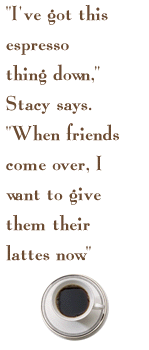

|
page 2 of 4 |
 |
While the need to project a certain sense of corporate propriety
prevents Starbucks from explicitly
promoting the colonialist appeal of their business, they clearly
recognize its value as a marketing
device. To capitalize on it without provoking the usual bleating
from do-good reformists, the company
employs a simple but effective technique. Instead of delivering
its message all at once, the
Starbucks copywriters divide it into two component parts--affluent
assumption and third-world misery--and
then they highlight these two parts in separate pieces of promotional
literature. It's a clever way of
sidestepping the political correctness that inhibits too many
corporations these days.
For a more specific example of how the process works, consider the September/October 1995 issue of Coffee Matters, a four-page newsletter that Starbucks publishes on a bi-monthly basis. That particular issue contains an article entitled "At Home With Espresso," which presents five "scenarios" designed to help potential espresso machine buyers divine which of the many similar contraptions in the Starbucks product line is the correct one for them. Here is a brief description of each scenario: 1. A busy couple needs to get a wedding gift for some people they don't like that much. 2. A recent college grad wants to buy a better machine than the one he kept in his dorm room. 3. A woman who just bought her first house is shopping for the "necessities" to fill it with. 4. An affluent, status-conscious couple want to give their guests the "Starbucks Experience" when they entertain. 5. A really affluent, really status-conscious guy wants a machine that will match his "peerless golf clubs." |


